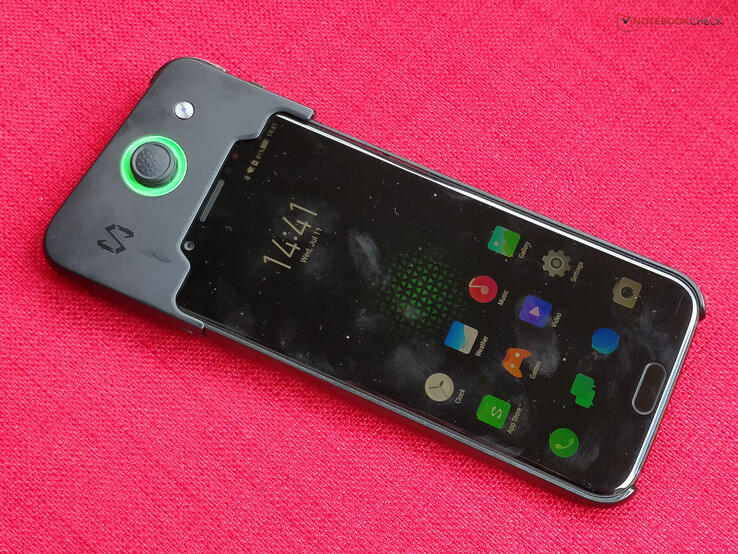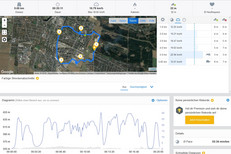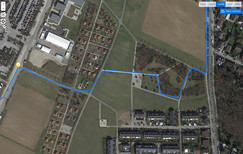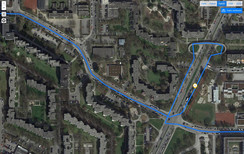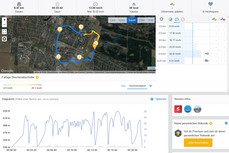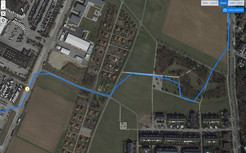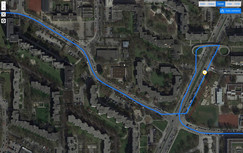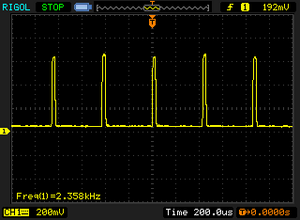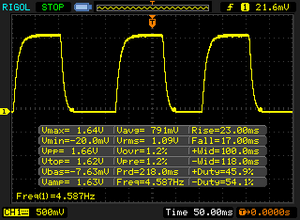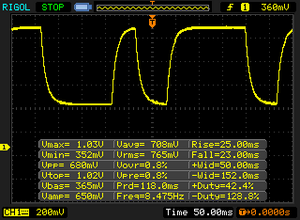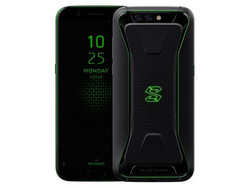Breve Análise do Smartphone Xiaomi Black Shark
Os Top 10
» Os Top 10 Portáteis Multimídia
» Os Top 10 Portáteis de Jogos
» Os Top 10 Portáteis Leves para Jogos
» Os Top 10 Portáteis Acessíveis de Escritório/Empresariais
» Os Top 10 Portáteis Premium de Escritório/Empresariais
» Os Top 10 dos Portáteis Workstation
» Os Top 10 Subportáteis
» Os Top 10 Ultrabooks
» Os Top 10 Conversíveis
» Os Top 10 Tablets
» Os Top 10 Smartphones
» A melhores Telas de Portáteis Analisadas Pela Notebookcheck
» Top 10 dos portáteis abaixo dos 500 Euros da Notebookcheck
» Top 10 dos Portáteis abaixo dos 300 Euros
Size Comparison
| Networking | |
| iperf3 transmit AX12 | |
| Razer Phone 2017 | |
| OnePlus 6 | |
| Samsung Galaxy S9 Plus | |
| Honor 10 | |
| Xiaomi Black Shark | |
| iperf3 receive AX12 | |
| Razer Phone 2017 | |
| Samsung Galaxy S9 Plus | |
| OnePlus 6 | |
| Honor 10 | |
| Xiaomi Black Shark | |
| |||||||||||||||||||||||||
iluminação: 95 %
iluminação com acumulador: 549 cd/m²
Contraste: 1307:1 (Preto: 0.42 cd/m²)
ΔE ColorChecker Calman: 6.08 | ∀{0.5-29.43 Ø4.78}
ΔE Greyscale Calman: 6.6 | ∀{0.09-98 Ø5}
100% sRGB (Calman 2D)
Gamma: 2.305
CCT: 8399 K
| Xiaomi Black Shark IPS, 2160x1080, 6" | Razer Phone 2017 IGZO LCD, 120 Hz, Wide Color Gamut, 1440x2560, 5.7" | OnePlus 6 Optic AMOLED, 2280x1080, 6.3" | Honor 10 IPS, 2280x1080, 5.8" | Samsung Galaxy S9 Plus Super AMOLED, 2960x1440, 6.2" | |
|---|---|---|---|---|---|
| Screen | 25% | 22% | 20% | 33% | |
| Brightness middle (cd/m²) | 549 | 436 -21% | 430 -22% | 555 1% | 565 3% |
| Brightness (cd/m²) | 541 | 417 -23% | 437 -19% | 537 -1% | 571 6% |
| Brightness Distribution (%) | 95 | 92 -3% | 87 -8% | 94 -1% | 96 1% |
| Black Level * (cd/m²) | 0.42 | 0.16 62% | 0.39 7% | ||
| Contrast (:1) | 1307 | 2725 108% | 1423 9% | ||
| Colorchecker dE 2000 * | 6.08 | 3.88 36% | 2.3 62% | 2.3 62% | 2.3 62% |
| Colorchecker dE 2000 max. * | 10.69 | 7.96 26% | 4.6 57% | 6 44% | 4.8 55% |
| Greyscale dE 2000 * | 6.6 | 5.8 12% | 2.4 64% | 3.9 41% | 1.9 71% |
| Gamma | 2.305 95% | 2.45 90% | 2.28 96% | 2.19 100% | 2.16 102% |
| CCT | 8399 77% | 7657 85% | 6160 106% | 6212 105% | 6332 103% |
* ... menor é melhor
Cintilação da tela / PWM (modulação por largura de pulso)
| Tela tremeluzindo/PWM detectado | 2358 Hz | ≤ 15 % configuração de brilho | |
A luz de fundo da tela pisca em 2358 Hz (pior caso, por exemplo, utilizando PWM) Cintilação detectada em uma configuração de brilho de 15 % e abaixo. Não deve haver cintilação ou PWM acima desta configuração de brilho. A frequência de 2358 Hz é bastante alta, então a maioria dos usuários sensíveis ao PWM não deve notar nenhuma oscilação. [pwm_comparison] Em comparação: 53 % de todos os dispositivos testados não usam PWM para escurecer a tela. Se PWM foi detectado, uma média de 8091 (mínimo: 5 - máximo: 343500) Hz foi medida. | |||
Exibir tempos de resposta
| ↔ Tempo de resposta preto para branco | ||
|---|---|---|
| 40 ms ... ascensão ↗ e queda ↘ combinadas | ↗ 23 ms ascensão | |
| ↘ 17 ms queda | ||
| A tela mostra taxas de resposta lentas em nossos testes e será insatisfatória para os jogadores. Em comparação, todos os dispositivos testados variam de 0.1 (mínimo) a 240 (máximo) ms. » 97 % de todos os dispositivos são melhores. Isso significa que o tempo de resposta medido é pior que a média de todos os dispositivos testados (20.2 ms). | ||
| ↔ Tempo de resposta 50% cinza a 80% cinza | ||
| 48 ms ... ascensão ↗ e queda ↘ combinadas | ↗ 25 ms ascensão | |
| ↘ 23 ms queda | ||
| A tela mostra taxas de resposta lentas em nossos testes e será insatisfatória para os jogadores. Em comparação, todos os dispositivos testados variam de 0.165 (mínimo) a 636 (máximo) ms. » 82 % de todos os dispositivos são melhores. Isso significa que o tempo de resposta medido é pior que a média de todos os dispositivos testados (31.6 ms). | ||
| AnTuTu v6 - Total Score (classificar por valor) | |
| Xiaomi Black Shark | |
| OnePlus 6 | |
| Honor 10 | |
| Samsung Galaxy S9 Plus | |
| Média Qualcomm Snapdragon 845 (162183 - 242953, n=23) | |
| AnTuTu v7 - Total Score (classificar por valor) | |
| Xiaomi Black Shark | |
| Razer Phone 2017 | |
| OnePlus 6 | |
| Honor 10 | |
| Samsung Galaxy S9 Plus | |
| Média Qualcomm Snapdragon 845 (246366 - 299878, n=27) | |
| PCMark for Android | |
| Work performance score (classificar por valor) | |
| Razer Phone 2017 | |
| OnePlus 6 | |
| Honor 10 | |
| Samsung Galaxy S9 Plus | |
| Média Qualcomm Snapdragon 845 (7998 - 13211, n=26) | |
| Work 2.0 performance score (classificar por valor) | |
| Xiaomi Black Shark | |
| Razer Phone 2017 | |
| OnePlus 6 | |
| Honor 10 | |
| Samsung Galaxy S9 Plus | |
| Média Qualcomm Snapdragon 845 (7360 - 9868, n=27) | |
| GFXBench 3.1 | |
| on screen Manhattan ES 3.1 Onscreen (classificar por valor) | |
| Xiaomi Black Shark | |
| Razer Phone 2017 | |
| OnePlus 6 | |
| Honor 10 | |
| Samsung Galaxy S9 Plus | |
| Média Qualcomm Snapdragon 845 (21 - 59, n=27) | |
| Média da turma Smartphone (11 - 166, n=157, últimos 2 anos) | |
| 1920x1080 Manhattan ES 3.1 Offscreen (classificar por valor) | |
| Xiaomi Black Shark | |
| Razer Phone 2017 | |
| OnePlus 6 | |
| Honor 10 | |
| Samsung Galaxy S9 Plus | |
| Média Qualcomm Snapdragon 845 (32 - 61, n=28) | |
| Média da turma Smartphone (8.4 - 413, n=156, últimos 2 anos) | |
| Octane V2 - Total Score | |
| Média da turma Smartphone (2228 - 121337, n=197, últimos 2 anos) | |
| OnePlus 6 (Chrome 66) | |
| Samsung Galaxy S9 (Samsung Browser 7.0) | |
| Média Qualcomm Snapdragon 845 (3991 - 18275, n=28) | |
| Xiaomi Black Shark (Firefox 61) | |
| Razer Phone 2017 (Chrome 65) | |
| Honor 10 (Chrome 66) | |
| Mozilla Kraken 1.1 - Total | |
| Honor 10 (Chrome 66) | |
| Razer Phone 2017 (Chrome 65) | |
| Média Qualcomm Snapdragon 845 (2154 - 11204, n=28) | |
| OnePlus 6 (Chrome 66) | |
| Xiaomi Black Shark (Firefox 61) | |
| Samsung Galaxy S9 (Samsung Browser 7.0) | |
| Média da turma Smartphone (257 - 28190, n=155, últimos 2 anos) | |
| WebXPRT 2015 - Overall | |
| OnePlus 6 (Chrome 66) | |
| Xiaomi Black Shark (Firefox 61) | |
| Média Qualcomm Snapdragon 845 (96 - 291, n=23) | |
| Honor 10 (Chrome 66) | |
| Samsung Galaxy S9 (Samsung Browser 7.0) | |
| WebXPRT 3 - Overall | |
| Média da turma Smartphone (38 - 380, n=31, últimos 2 anos) | |
| OnePlus 6 (Chrome 66) | |
| Média Qualcomm Snapdragon 845 (19 - 103, n=17) | |
| Xiaomi Black Shark (Firefox 61) | |
| Honor 10 (Chrome 66) | |
| Samsung Galaxy S9 | |
* ... menor é melhor
| Xiaomi Black Shark | Razer Phone 2017 | OnePlus 6 | Honor 10 | Samsung Galaxy S9 Plus | Média 64 GB UFS 2.1 Flash | Média da turma Smartphone | |
|---|---|---|---|---|---|---|---|
| AndroBench 3-5 | -19% | -19% | 17% | -16% | -3% | 340% | |
| Sequential Read 256KB (MB/s) | 742 | 732 -1% | 726 -2% | 828 12% | 819 10% | 696 ? -6% | 2228 ? 200% |
| Sequential Write 256KB (MB/s) | 199.6 | 202.5 1% | 201.4 1% | 192.1 -4% | 204.9 3% | 224 ? 12% | 1852 ? 828% |
| Random Read 4KB (MB/s) | 127.2 | 142.5 12% | 137 8% | 145.9 15% | 129.7 2% | 137.2 ? 8% | 296 ? 133% |
| Random Write 4KB (MB/s) | 114.1 | 14.3 -87% | 21.8 -81% | 163 43% | 22.74 -80% | 84.7 ? -26% | 339 ? 197% |
| Sequential Read 256KB SDCard (MB/s) | 79.4 | 79.2 ? | 68.6 ? | ||||
| Sequential Write 256KB SDCard (MB/s) | 52.5 | 67.2 ? | 52.2 ? |
| Arena of Valor | |||
| Configurações | Valor | ||
| high HD | 60 fps | ||
| high HD | 60 fps | ||
| Minecraft - Pocket Edition | |||
| Configurações | Valor | ||
| fancy graphics, beautiful skies, 74% viewing range | 60 fps | ||
(-) A temperatura máxima no lado superior é 49.5 °C / 121 F, em comparação com a média de 35.2 °C / 95 F , variando de 21.9 a 247 °C para a classe Smartphone.
(±) A parte inferior aquece até um máximo de 43.6 °C / 110 F, em comparação com a média de 34 °C / 93 F
(+) Em uso inativo, a temperatura média para o lado superior é 30.9 °C / 88 F, em comparação com a média do dispositivo de 32.9 °C / ### class_avg_f### F.
Xiaomi Black Shark análise de áudio
(±) | o volume do alto-falante é médio, mas bom (###valor### dB)
Graves 100 - 315Hz
(±) | graves reduzidos - em média 12.8% menor que a mediana
(±) | a linearidade dos graves é média (12.7% delta para a frequência anterior)
Médios 400 - 2.000 Hz
(±) | médios mais altos - em média 5.9% maior que a mediana
(+) | médios são lineares (3.4% delta para frequência anterior)
Altos 2 - 16 kHz
(+) | agudos equilibrados - apenas 2.7% longe da mediana
(+) | os máximos são lineares (6.9% delta da frequência anterior)
Geral 100 - 16.000 Hz
(±) | a linearidade do som geral é média (21.3% diferença em relação à mediana)
Comparado com a mesma classe
» 40% de todos os dispositivos testados nesta classe foram melhores, 8% semelhantes, 51% piores
» O melhor teve um delta de 11%, a média foi 35%, o pior foi 134%
Comparado com todos os dispositivos testados
» 59% de todos os dispositivos testados foram melhores, 7% semelhantes, 34% piores
» O melhor teve um delta de 4%, a média foi 24%, o pior foi 134%
Razer Phone 2017 análise de áudio
(±) | o volume do alto-falante é médio, mas bom (###valor### dB)
Graves 100 - 315Hz
(-) | quase nenhum baixo - em média 19.3% menor que a mediana
(±) | a linearidade dos graves é média (10.6% delta para a frequência anterior)
Médios 400 - 2.000 Hz
(+) | médios equilibrados - apenas 3.4% longe da mediana
(+) | médios são lineares (4.4% delta para frequência anterior)
Altos 2 - 16 kHz
(+) | agudos equilibrados - apenas 1.7% longe da mediana
(+) | os máximos são lineares (3% delta da frequência anterior)
Geral 100 - 16.000 Hz
(±) | a linearidade do som geral é média (16% diferença em relação à mediana)
Comparado com a mesma classe
» 5% de todos os dispositivos testados nesta classe foram melhores, 4% semelhantes, 91% piores
» O melhor teve um delta de 11%, a média foi 35%, o pior foi 134%
Comparado com todos os dispositivos testados
» 24% de todos os dispositivos testados foram melhores, 5% semelhantes, 70% piores
» O melhor teve um delta de 4%, a média foi 24%, o pior foi 134%
| desligado | |
| Ocioso | |
| Carga |
|
Key:
min: | |
| Xiaomi Black Shark 4000 mAh | Razer Phone 2017 4000 mAh | OnePlus 6 3300 mAh | Honor 10 3400 mAh | Samsung Galaxy S9 Plus 3500 mAh | Média Qualcomm Snapdragon 845 | Média da turma Smartphone | |
|---|---|---|---|---|---|---|---|
| Power Consumption | -7% | 23% | -15% | 32% | -1% | -6% | |
| Idle Minimum * (Watt) | 0.8 | 0.83 -4% | 0.6 25% | 1.12 -40% | 0.68 15% | 0.862 ? -8% | 0.845 ? -6% |
| Idle Average * (Watt) | 1.5 | 2.11 -41% | 1 33% | 2.26 -51% | 0.95 37% | 1.728 ? -15% | 1.44 ? 4% |
| Idle Maximum * (Watt) | 2.3 | 2.24 3% | 1.6 30% | 2.3 -0% | 1.09 53% | 2.07 ? 10% | 1.625 ? 29% |
| Load Average * (Watt) | 4.8 | 4.94 -3% | 4.3 10% | 5.14 -7% | 4.58 5% | 4.87 ? -1% | 7.01 ? -46% |
| Load Maximum * (Watt) | 10.1 | 9.08 10% | 8.6 15% | 7.89 22% | 5.16 49% | 9.27 ? 8% | 11.3 ? -12% |
* ... menor é melhor
| Xiaomi Black Shark 4000 mAh | Razer Phone 2017 4000 mAh | OnePlus 6 3300 mAh | Honor 10 3400 mAh | Samsung Galaxy S9 Plus 3500 mAh | |
|---|---|---|---|---|---|
| Duração da bateria | 7% | 4% | -17% | -16% | |
| Reader / Idle (h) | 29.2 | 30.1 3% | 19.4 -34% | 22.4 -23% | |
| H.264 (h) | 12.5 | 13.2 6% | 11 -12% | 11.2 -10% | |
| WiFi v1.3 (h) | 11.9 | 12.7 7% | 12.7 7% | 11.1 -7% | 8.7 -27% |
| Load (h) | 4.2 | 4.1 -2% | 3.6 -14% | 4 -5% |
Pro
Contra
Dado o fato de que o Xiaomi Black Shark não está disponível como uma versão global por enquanto, outros telefones de jogos são definitivamente uma opção mais razoável para os clientes europeus: O Black Shark exige que o usuário instale os serviços do Google manualmente, e o software só está disponível em inglês com partes de chinês. É questionável se o usuário pode se conectar à rede LTE europeia. O Wi-Fi é lento e a garantia está ausente.
Mas desde quando jogar é razoável? O Xiaomi Black Shark é extremamente estiloso, e é um dos smartphones mais velozes até hoje, alcançando facilmente 60 fps, mesmo nos jogos mais exigentes. Também é relativamente barato, o que torna tudo isto não tão irracional depois de tudo.
O Xiaomi Black Shark não é um smartphone de jogos para todos, mas é um dispositivo excepcional com muita potência e uma ótima carcaça.
Em comparação direta com o Razer Phone 2017, a desvantagem mais importante do Black Shark é o máximo de fps mais baixos da tela. O Razer Phone é um pacote geral mais completo. No entanto, os usuários chamarão mais a atenção com o exótico dispositivo de jogos da Xiaomi, então podemos definitivamente recomendá-lo para jogadores que preferem um toque de individualidade e que não se importam de ter que mexer um pouco no software do seu dispositivo.
Xiaomi Black Shark
- 07/13/2018 v6 (old)
Florian Wimmer




